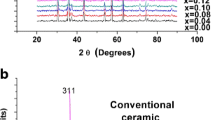Abstract
Sol–gels with different CA/MN ratios, reverse coprecipitation, and solid reaction methods have been applied to carry out MgFe2O4 magnetic material. The influence of synthesis parameters was characterized by using analytical tools, such as high-resolution neutron diffraction, a B-H analyzer, and SEM technique. Using a temperature increasing measurement apparatus, the heat generation ability was also analyzed in the AC magnetic field. Structural analysis reveals that all of the samples possess cubic and ferrimagnetic structures corresponding to the space group Fd3m and lattice constant a ≈ 8.4 Å. Fitting high-resolution neutron diffraction data indicate that the degree of inversion in synthesized ferrites is between 0.78 and 0.95. There were significant correlations observed between temperature enhancement ability and chemical synthesis methods.

Highlights
-
MgFe2O4 was prepared by various methods and characterized.
-
Crystal and magnetic structures were discussed.
-
Synthesis parameters were affected by cation distributions and temperature enhancements of ferrites.






Similar content being viewed by others
References
Suriyanto EYKNg, Kumar SD (2017) Physical mechanism and modeling of heat generation and transfer in magnetic fluid hyperthermia through Neelian and Brownian relaxation: a review. BioMed Eng Online 16:1–36
Hirazawa H, Aono H et al. (2013) Heat generation ability of nanosized Mg1-XCuXFe2O4 ferrite in an AC magnetic field. J Mag Soc Jpn 37:291–294
Sardarim D, Verga N (2013) Cancer treatment with hyperthermia. In: Ozdemir O (ed) Current cancer treatment—novel beyond conventional approaches. InTech Press, UK, p 455–474
Johansnsen M et al. (2007) Thermotherapy of prostate cancer using magnetic nanoparticles: feasibility, imaging, and three-dimensional temperature distribution. Eur Urol 52:1653–1662
Cole AJ, Yang VC, David AE (2011) Cancer theranostics: the rise of targeted magnetic nanoparticles. Trends Biotechnol 29:323–332
Melagiriyappa E, Jayanna HS (2009) Structural and magnetic susceptibility studies of samarium substituted magnesium–zinc ferrites. J Alloy Compd 482:147–150
Wu W, Wu Z, Yu T, Jiang C, Kim W (2015) Recent progress on magnetic iron oxide nanoparticles: synthesis, surface functional strategies and biomedical applications. Sci Technol Adv Mater 16:3161–3164
Antao SM, Hassan I, Parise JB (2005) Cation ordering in magnesioferrite, MgFe2O4, to 982 °C using in situ synchrotron X-ray powder diffraction. Am Mineral 90:219–228
Balagurov AM (2005) High-resolution fourier diffraction at the IBR-2 reactor. Neutron News 16:8–12
Aono H, Hirazawa H, Naohara T, Maehara T, Kikkawa H, Watanabe Y (2005) Synthesis of fine magnetite powder using reverse coprecipitation method and its heating properties by applying AC magnetic field. J Mater Res Bull 40:1126–1135
Zlokazov VB, Chernyshev VV (1992) MRIA—a program for a full profile analysis of powder multiphase neutron-diffraction time-of-flight (direct and Fourier) spectra. J Appl Crystallogr 25:447–451
Rodríguez-Carvajal J (1993) Recent advances in magnetic structure determination by neutron powder diffraction. Physica B 192:55–69
Williamson GK, Hall WH (1953) X-ray line broadening from filed aluminium and wolfram. Acta Metall 1:22–31
Uyanga E et al. (2018) Structural investigation of chemically synthesized ferrite magnetic nanomaterials. J Mol Struct 1160:447–454
O’Neill HStC, Annersten H, Virgo D (1992) The temperature dependence of the cation distribution in magnesioferrite (MgFe2O4) from powder XRD structural refinements and Mössbauer spectroscopy. Am Mineral 77:725–740
Utsunomiya S et al. (2013) Heat generation ability of nanosized Mg1-xCuxFe2O4 ferrite in an AC magnetic field. J Magn Soc Jpn 37:291–294
Mohammad AM, Ali Ridha SM, Mubarak TH (2018) Structural and magnetic properties of Mg-Co ferrite nanoparticles. Dig J Nanomater Biostruct 13:615–623
Khishigdemberel I, Uyanga E, Hirazawa H, Sangaa D (2018) Influence of Cu dope on the structural behavior of MgFe2O4 at various temperatures. Phys B 544:73–78
Neel L (1948) Magnetic properties of ferrites: ferromagnetism and anti-ferromagnetism. Ann Phys 3:137–198
Balagurov AM et al. (2015) Interplay between structural and magnetic phase transitions in copper ferrite studied with high-resolution neutron diffraction. J Magn Magn Mater 374:591–599
Li Y, Xue L, Fan L, Yan Y (2009) The effect of citric acid to metal nitrates molar ratio on sol–gel combustion synthesis of nanocrystalline LaMnO3 powders. J Alloy Compd 478:493–497
Mohapatra J, Xing M, Liu JP (2019) Inductive thermal effect of ferrite magnetic nanoparticles. Materials 12:3208–3238
Acknowledgements
Neutron diffraction experiments were performed on the IBR-2 (JINR, Russia) neutron source. This work was supported by the RFBR Mongolian—Russian joint project (No. 17-52-44024) and by the JSPS KAKENHI Grant Number JP18K05283.
Author information
Authors and Affiliations
Corresponding author
Ethics declarations
Conflict of interest
The author declares that they have no conflict of interest.
Additional information
Publisher’s note Springer Nature remains neutral with regard to jurisdictional claims in published maps and institutional affiliations.
Rights and permissions
About this article
Cite this article
Uyanga, E., Hirazawa, H., Sakai, T. et al. Correlation between synthesis and physical properties of magnesium ferrite. J Sol-Gel Sci Technol 95, 223–229 (2020). https://doi.org/10.1007/s10971-020-05247-6
Received:
Accepted:
Published:
Issue Date:
DOI: https://doi.org/10.1007/s10971-020-05247-6




